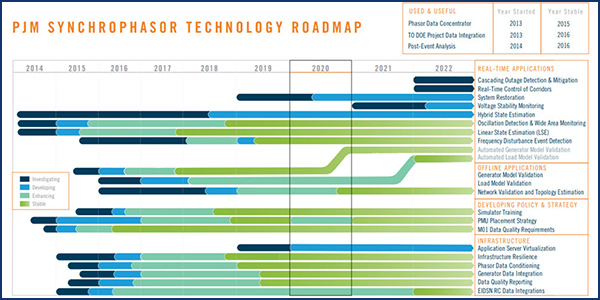PJM stakeholders endorsed “quick-fix” manual revisions to expand the use of synchrophasors and make them a requirement for certain projects under the Regional Transmission Expansion Plan (RTEP).
The revisions, which have been debated for several months at the Planning Committee, passed with 89% support and 136 “yes” votes at the committee’s meeting July 7. Members were originally scheduled to vote at last month’s PC meeting, but several stakeholders raised objections over PJM’s proposals. (See PMU Vote Delayed by PJM.)
Dave Souder, PJM’s senior director of system planning, said the proposed solution was modified based on stakeholder feedback over the last month. Souder said language was changed to indicate the synchrophasor requirements will only apply to new baseline and supplemental projects presented to the Transmission Expansion Advisory Committee or the subregional RTEP committees for inclusion in the RTEP after June 1, 2021.
Shaun Murphy of PJM reviewed the problem statement, issue charge and proposed solution of language in Manual 1 and Manual 14B requiring synchrophasors — also known as phasor measurement units (PMUs).
For new substations with three or more non-radial transmission lines at 100 kV or above, synchrophasor measurement signals will be required for:
- bus voltages at 100 kV and above;
- line-terminal voltage and current values for transmission lines at 100 kV and above;
- high-side/low-side voltage and current values for transformers at 100 kV and above; and
- dynamic reactive device power output (SVC, STATCOM and synchronous condensers).
The manual language adds a PMU Placement Strategy (PPS) including placement targets and required operational dates for the devices needed to support PJM’s real-time synchrophasor applications.
Murphy said PJM’s vision for the “grid of the future” includes a system with full observability of all equipment of 100 kV and above and that synchrophasors are a key part of that. He pointed out the benefits of PMUs, including the ability to detect grid disturbances from oscillation events and equipment failures in real time and the ability for detailed analysis after a major outage.
The installation of PMUs was a recommendation following the Northeast blackout of 2003, Murphy said, an event that lasted for four days, impacted 50 million people and carried an estimated cost of $6 billion.
Costs Questioned
PJM estimates costs of about $8 million for as many as 80 PMU installation projects annually based on historical numbers of substation projects proposed in the RTEP process. The RTO said it costs about $120,000 to make a substation “PMU ready” in addition to the $10,000 cost for a single PMU.
Delaware Deputy Public Advocate Ruth Ann Price said she was still not clear as to how many PMUs the RTO is looking to install.
Souder said the most recent query of the PJM energy management system found 4,100 substations at 100 kV and above. PJM currently has about 400 PMUs in place, he said, most of them installed between 2009 and 2013 with funding from the U.S. Department of Energy’s Smart Grid Investment Grant.
PJM’s approach is to do PMU installation in a “cost-effective manner,” Souder said, focusing on substation projects where PMUs can be built into the engineering and design stage rather than having to go back to retrofit a substation.
Souder said PJM has also committed to re-evaluating its PMU strategy every five years to move forward selectively when enough synchrophasors are in place to provide accurate, real-time information. Souder said the installation process will take at least 10 years to get to a point of system effectiveness, but not all of the 4,100 substations that fit the installation criteria will need to have PMUs for the monitoring system to work.
Stakeholder Opinions
Dave Mabry of the PJM Industrial Customer Coalition said he still had concerns that the proposed manual language will increase the justification of supplemental projects, which are reserved for incumbent transmission owners and not subject to competitive bidding.
Greg Poulos, executive director of the Consumer Advocates of the PJM States, said the advocates are very supportive of innovation but are concerned by the cost-benefit analysis. He said the installation of smart meters over the last decade has been an expensive endeavor whose cost has outweighed the benefits in some cases.
“As those who will be paying for this, the cost-benefit is going to be the number one question I get,” Poulos said.
Adrien Ford of Old Dominion Electric Cooperative said she went into the PC meeting last month expecting to endorse the proposed manual revisions but was glad to take more time after additional questions were raised by stakeholders. Ford said the extra month of discussions with PJM over the manual language led to important changes that made the solution stronger.
“I think this is a good example of collaboration between stakeholders and PJM to get the manuals strengthened with input,” Ford said.







